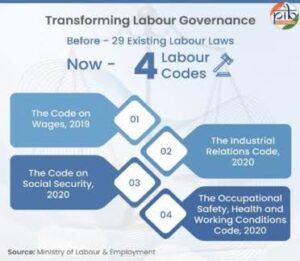Digital News Guru National Desk:
Trade Unions Mount Fierce Opposition to India’s New Labour Codes, Announce Nationwide Protests
A coalition of ten major Indian trade unions has launched a sharp attack on the government’s newly implemented labour codes, denouncing them as a “deceptive fraud” that erodes workers’ rights. The unions — many aligned with parties opposing Prime Minister Narendra Modi — have called for a nationwide protest on November 26 to demand the withdrawal of these laws.
What the New Codes Say (According to the Government)
The government has activated four labour codes that were approved several years ago: the Code on Wages (2019), Industrial Relations Code (2020), Code on Social Security (2020), and the Occupational Safety, Health and Working Conditions Code (2020).

According to the Ministry of Labour, these reforms aim to modernize India’s patchwork of labour laws, some of which date back to the colonial era. The government argues that the codes will provide broader social security, ensure minimum and timely wages, and improve safety standards in workplaces.
A key feature is the formal recognition of gig and platform workers within the social security framework — a move the government says will give millions of informal workers access to benefits like provident fund, insurance, and health coverage.
Why Unions Are Angry
The trade unions are not taking the changes lightly. They claim that the codes were pushed through in a unilateral and undemocratic manner, without giving adequate weight to workers’ voices. In a strongly worded joint statement, the unions have labelled the government’s actions as “anti-worker, pro-employer.”
Some of their most serious concerns include:
- Ease of hiring and firing: The new rules make it simpler for companies to hire and terminate employees, potentially reducing job security.
- Expanded shifts: The codes allow for longer working hours, including permitting women to work night shifts — a point unions say could seriously compromise worker safety.
- Layoffs threshold: Firms only need government approval for layoffs if they have 300 or more workers, up from the previous threshold of 100, giving companies greater flexibility.
- Worker exploitation risk: Several unions argue that these codes undermine decades of labour protections — including the right to strike, collective bargaining, and safe working conditions.
Some union leaders have gone as far as calling the labour codes a “genocidal attack” on workers, accusing the government of trying to impose “virtual slavery.”
The Protests: What’s Planned
In response to the codes, the Joint Platform of Central Trade Unions has scheduled nationwide demonstrations for November 26. They are also calling on workers to wear black badges at their workplaces as a symbolic protest against the government’s decision.

Some early protests have already begun: for example, the Centre of Indian Trade Unions (CITU) organized a march in Bhubaneswar, where protestors burned copies of the newly notified codes.
These unions have a history of mobilization. Earlier this year, they claimed that a general strike involving 25 crore workers took place, protesting not just the codes but a broader set of labour-related grievances.
Not All Unions Are Against the Codes
Importantly, opposition is not unanimous among labour organizations. The Bharatiya Mazdoor Sangh (BMS) — which has ideological links to the ruling party — has not called for a full repeal. Instead, it has urged for a phased implementation of the codes.
While BMS supports the Wage Code and the Social Security Code, it has expressed reservations over certain provisions in the Industrial Relations Code and the Safety & Working Conditions Code, calling for reform rather than a full rollback.
Political and Economic Stakes
The labour code overhaul is not merely a regulatory reform; it has significant political and economic implications.
- Political tension: Many of the unions protesting are aligned with opposition parties, turning the labour reform into a flashpoint in the political discourse.
- Economic reform: The government argues that by simplifying labour laws, India will become more attractive to investors and businesses, thus promoting growth and employment.
- Social security expansion: By including gig workers in the social protection net, the new codes could benefit a large, previously marginalized workforce.
- Business concerns: On the flip side, some business groups argue that compliance costs could rise, especially for small and medium enterprises.

What Comes Next
With protests now formally planned, the government faces a challenging balancing act. It must defend its labour reform as progressive and modernizing, while addressing serious concerns raised by the unions.
Potential developments to watch:
- Dialogue or deadlock: Will the Labour Ministry engage meaningfully with the protesting unions, or will the confrontation deepen?
- State-level implementation: Since labour is a concurrent subject in India, states will need to write their own rules in alignment with the new federal codes — a process that could lead to variation and further contention.
- Public mobilization: If the November 26 protest gains traction, there could be sustained pressure on the government, potentially forcing a renegotiation or partial rollback.
- Legal challenges: Depending on how the codes are applied, unions may also move to court, challenging specific provisions that they believe undermine worker rights.
In sum, the rollout of India’s new labour codes represents one of the most significant overhauls of its labour law framework in decades. While the government pitches it as a forward-looking reform aimed at modernization and expanded social security, trade unions see it as a rollback of hard-won protections and a deliberate tilt toward corporate interests. The protests planned later this week could either serve as a moment of bargaining or mark the beginning of a sustained labour-political struggle.
You May Also Read: Indian Tejas Fighter Jet Crashes at Dubai Airshow








